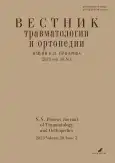Modern aspects in the treatment of intra-articular fractures and fractures of the proximal interphalangeal joints of the three-phalangeal fingers of the hand, as well as their consequences
- 作者: Golubev I.O.1, Merkulov M.V.1, Kusnetsov V.D.1, Bushuev O.M.1, Kutepov I.A.1, Baliura G.G.1
-
隶属关系:
- Priorov National Medical Research Center of Traumatology and Orthopedics
- 期: 卷 30, 编号 3 (2023)
- 页面: 287-300
- 栏目: Original study articles
- URL: https://bakhtiniada.ru/0869-8678/article/view/217904
- DOI: https://doi.org/10.17816/vto321379
- ID: 217904
如何引用文章
详细
BACKGROUND: Proximal interphalangeal joint intra-articular fractures are a prevalent problem in traumatology and orthopedics. Damage typically develops at the base of the middle phalanx due to a collision with the head of the proximal phalanx. As a result, the finger’s function declines significantly, which inevitably impacts the function of the entire brush. Compared with long-standing injuries, treating patients with this pathology in the acute period of injury is more likely to result in limb function restoration. Suppose an intra-articular fracture is underestimated or missed in the early stages. In that case, the doctor may eventually encounter chronic pain syndrome, joint and/or stiffness, and more time-consuming treatment procedures. There are many methods of treatment for both “acute” and long-standing injuries, each with advantages and disadvantages.
OBJECTIVE: To describe, in our opinion, the most effective modalities of therapy for patients with these injuries in the early stages (up to 4 weeks from the time of injury) and long-term periods (more than 4 weeks).
MATERIALS AND METHODS: The Suzuki external fixation spoke device (pins and rubber traction system [PRTS]) was used to treat 26 patients with fractures and dislocations of the base of the middle phalanx of the three-phalangeal fingers of the hand in the acute period of injury. Arthroplasty of the base of the middle phalanx with a hook bone graft (hemihamate) with its modifications was used in the treatment of 23 patients with inadequately fused intra-articular fractures of the base of the middle phalanx of the three-phalangeal fingers of the hand. All patients underwent physical examinations, X-rays, and/or CT scans to diagnose and confirm or clarify the nature of the damage. All patients developed passive/active movements early in the operated section during the postoperative period.
RESULTS: The patient estimated the VAS pain syndrome at 4–6 points on the scale; however, after 6–8 weeks, this indicator was 0–1 points. After 6–8 weeks, the amplitude of movements in the proximal interphalangeal joint of the fingers from the average of 30–50° after 6–8 weeks, was reached the average of 15–95°. There was a 15–20° extensor contracture in two patients.
CONCLUSION: The treatment of patients with intra-articular fractures and fracture-dislocations in the proximal interphalangeal joint of the three-phalangeal fingers of the hand, as well as their consequences, is a complex current problem in traumatology and orthopedics with no one-word universal solution. To select treatment strategies, a comprehensive evaluation of the patient, correct verification and interpretation of the existing damage, and a thorough understanding of the anatomy of the fingers and the hand are required.
作者简介
Igor Golubev
Priorov National Medical Research Center of Traumatology and Orthopedics
Email: iog305@mail.ru
ORCID iD: 0000-0002-1291-5094
SPIN 代码: 2090-0471
MD, Dr. Sci. (Med.), Traumatologist-Orthopedist
俄罗斯联邦, MoscowMaksim Merkulov
Priorov National Medical Research Center of Traumatology and Orthopedics
Email: mailmerkulovmv@cito-priorov.ru
ORCID iD: 0009-0004-9362-3449
SPIN 代码: 4695-3570
MD, Dr. Sci. (Med.), Traumatologist-Orthopedist
俄罗斯联邦, MoscowVasily Kusnetsov
Priorov National Medical Research Center of Traumatology and Orthopedics
编辑信件的主要联系方式.
Email: dr.kuznetsovvd@gmail.com
ORCID iD: 0000-0003-1745-8010
SPIN 代码: 4093-7566
Post-Graduate Student, Traumatologist-Orthopedist
俄罗斯联邦, MoscowOleg Bushuev
Priorov National Medical Research Center of Traumatology and Orthopedics
Email: bushuevom@cito-priorov.ru
ORCID iD: 0009-0002-0051-2666
SPIN 代码: 9793-5486
MD, Cand. Sci. (Med.), Traumatologist-Orthopedist
俄罗斯联邦, MoscowIlya Kutepov
Priorov National Medical Research Center of Traumatology and Orthopedics
Email: kutepovia@cito-priorov.ru
ORCID iD: 0009-0001-3802-2577
SPIN 代码: 6598-7387
MD, Cand. Sci. (Med.), Traumatologist-Orthopedist
俄罗斯联邦, MoscowGrigoriy Baliura
Priorov National Medical Research Center of Traumatology and Orthopedics
Email: balyuragg@cito-priorov.ru
ORCID iD: 0000-0002-1656-1406
SPIN 代码: 6581-4371
MD, Cand. Sci. (Med.), Traumatologist-Orthopedist
俄罗斯联邦, Moscow参考
- Korshunov VF, Magdiev DA, Barsuk VI. Udlinenie kul’tej pal’cev kisti i ustranenie ukorochenij falang i pyastnyh kostej. Vestnik travmatologii i ortopedii im. N.N. Priorova. 2004;(1):66–70. (In Russ).
- Gil’mutdinova LT, Kutliahmetov NS, Sahabutdinova AR. Medicinskaya reabilitaciya bol’nyh s travmami verhnih konechnostej. Fundamental’nye issledovaniya. 2014;10(4):647–650. (In Russ).
- Korshunov VF, Magdiev DA, Barsuk VI. Stabil’nyj intramedullyarnyj osteosintez pri perelomah pyastnyh kostej i falang pal’cev kisti. Vestnik travmatologii i ortopedii im. N.N. Priorova. 2000;(2):22–26. (In Russ). doi: 10.17816/vto101596
- Caggiano NM, Harper CM, Rozental TD. Management of Proximal Interphalangeal Joint Fracture Dislocations. Hand Clinics. 2018;34(2):149–165. doi: 10.1016/j.hcl.2017.12.005
- Jha P, Bell D, Hacking C. Keifhaber-Stern classification of volar plate avulsion injuries of hand. Radiopaedia.org [cited 2023 Sep 26]. Available from: https://radiopaedia.org/articles/47255
- Jha P, Weerakkody Y, Hacking C, et al. Eaton classification of volar plate avulsion injury. Radiopaedia.org [cited 2023 Sep 26]. Available from: doi: 10.53347/rID-47254
- Lo CH, Nothdurft SH, Park H-S, Paul E, Leong J. Distraction ligamentotaxis for complex proximal interphalangeal joint fracture dislocations: a clinical study and the modified pins rubber band traction system revisited. Burns Trauma. 2018;6:23. doi: 10.1186/s41038-018-0124-1
- Suzuki Y, Matsunaga T, Sato S, Yokoi T. The pins and rubbers traction system for treatment of comminuted intraarticular fractures and fracture-dislocations in the hand. Journal of Hand Surgery (British and European Volume). 1994;19(1):98–107. doi: 10.1016/0266-7681(94)90059-0
补充文件




































